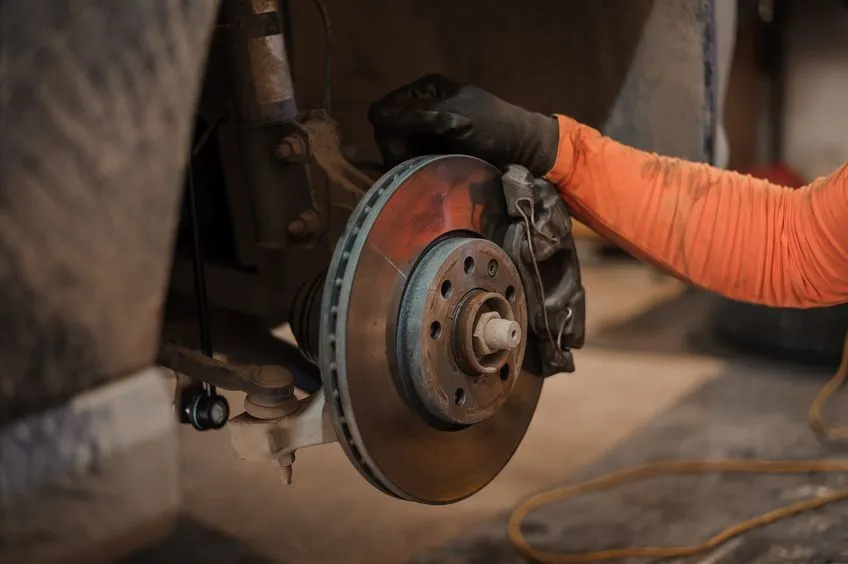How long do brake discs and pads last?

As you can imagine, it’s a good idea to keep your brake pads and discs in good condition and replace them when they start to wear out. But as well as keeping your eyes and ears open for telltale signs of disrepair such as squeaking brakes, it’s important to have an idea of roughly how long your braking system should last under normal driving conditions. That way, you can be prepared to replace worn out components before they cause a serious issue.
How long should brake discs last?
Brake discs are an integral part of the braking system, as they are what presses against the brake pads to cause the friction that helps to stop the vehicle. Just as this friction wears away the brake pads, it also has an effect on the brake discs, thinning them slowly with use. The original thickness of the brake discs when they come off the production line will vary from manufacturer to manufacturer, and each manufacturer will specify the minimum thickness that the discs are still roadworthy down to. Once the discs are thinner than this, it’s time to get them replaced. You should be able to find this information in your vehicle’s handbook, by consulting directly with the manufacturer, or by getting in touch with your local Mr Clutch Autocentre.
For a more general estimate of when your brake discs will need to be replaced, they’re typically expected to last for around 80,000 to 120,000 miles. So, if you drive 1,500 miles a month, that roughly equates to between four and seven years. Of course, the more you drive your car, the quicker your brake discs will wear out. Their lifespan can also be reduced by poor braking technique, such as resting your foot on the brake pedal while going down a long hill.
How long should brake pads last?
Typically, brake pads wear out quicker than brake discs. This is due to the material they’re made out of – brake discs are from hard metal, whereas the pads tend to use softer composites. As a rough estimate, brake pads last for between 30,000 and 70,000 miles – much less than brake discs – but this can vary widely depending on a range of factors.
Firstly, the material can play a role. Out of the three types of pads available, organic pads last the shortest time and ceramic pads last the longest, with metallic pads coming somewhere in between. On top of this, you can expect how and where you drive to have a big impact on the longevity of your brake pads.
Simply put, the more you use your brakes, the quicker the components will wear out. Therefore, if you do most of your driving in cities where there’s a lot of stopping and starting, you’ll probably find your brake pads wear out quicker than they would if you spend the majority of your time on the motorway at a reasonably consistent speed. The same also applies to the way you brake. If you have a tendency to slam on the brakes at the last minute, this high pressure, high friction situation will have a greater effect on your brake pads than if you were to anticipate the need to slow down ahead of time and ease off the accelerator to slow down naturally.
How to check brake pads
There are several ways you can get an insight into whether or not it’s time to replace your brake pads or discs. While you’re driving, you should keep your ears open for any unusual noises such as squeaking, screeching or grinding when you apply the brakes. It’s not guaranteed that a worn out component will be the issue, but it is a pretty good indicator that something is wrong and needs professional attention.
You should also be wary of any strange movement relating to your brakes. If the brake pedal feels spongy or light, this could be a sign of a problem. You might also notice the car pulling to one side slightly when you apply the brakes, which may mean there’s a problem with one set of brakes but not the other.
On top of this, visual indicators can be very useful. In some models of car, you might be able to actually inspect your brake pads and discs for wear and damage – in which case you should be able to see if they’re looking thin. If the pads are less than 3mm thick, it’s time to get them replaced. Alternatively, your car may have an indicator on the dashboard to tell you when your brake pads are getting thin. Make sure you’re familiar with the icons on your dashboard and what they mean.
Whether you’ve spotted an issue or you just want a professional to check your brakes over, the best thing you can do is to have your car serviced regularly. This will assess the condition and operation of your braking system so that problems can be resolved promptly before any further damage can be done.